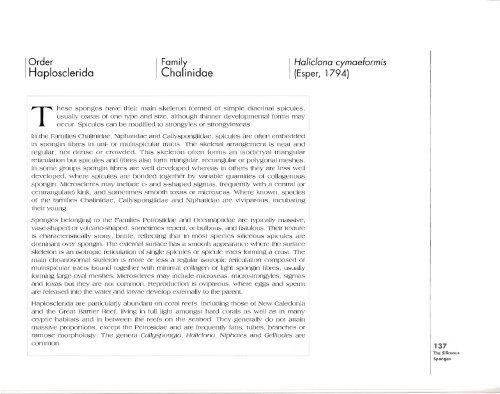Sponges of the New Caledonian lagoon - IRD
Sponges of the New Caledonian lagoon - IRD
Sponges of the New Caledonian lagoon - IRD
You also want an ePaper? Increase the reach of your titles
YUMPU automatically turns print PDFs into web optimized ePapers that Google loves.
Order<br />
Haplosclerida<br />
T hese<br />
Family<br />
Chalinidae<br />
sponges have <strong>the</strong>ir main skeleton formed <strong>of</strong> simple diactinal spicules,<br />
usually oxeas <strong>of</strong> one type and size, although thinner developmental forms may<br />
occur. Spicules can be modified to strongyles or strongyloxeas.<br />
In <strong>the</strong> Families Chalinidae, Niphatidae and Callyspongiidae, spicules are <strong>of</strong>ten embedded<br />
in spongin fibres in uni- or multispicular tracts. The skeletal arrangement is neat and<br />
regular, not dense or crowded. This skeleton <strong>of</strong>ten forms an isodictyal triangular<br />
reticulation but spicules and fibres also form triangular, rectangular or polygonal meshes.<br />
In some groups spongin fibres are well developed whereas in o<strong>the</strong>rs <strong>the</strong>y are less well<br />
developed, where spicules are bonded toge<strong>the</strong>r by variable quantities <strong>of</strong> collagenous<br />
spongin. Microscleres may include c- and s-shaped sigmas, frequently with a central (or<br />
centrangulate) kink, and sometimes smooth toxas or microxeas. Where known, species<br />
<strong>of</strong> <strong>the</strong> families Chalinidae, Callyspongiidae and Niphatidae are viviparous, incubating<br />
<strong>the</strong>ir young.<br />
<strong>Sponges</strong> belonging to <strong>the</strong> Families Petrosiidae and Oceanapiidae are typically massive,<br />
vase-shaped or volcano-shaped, sometimes repent, or bulbous, and fistulous. Their texture<br />
is characteristically stony, brittle, reflecting that in most species siliceous spicules are<br />
dominant over spongin. The external surface has a smooth appearance where <strong>the</strong> surface<br />
skeleton is an isotropic reticulation <strong>of</strong> single spicules or spicule tracts forming a crust. The<br />
main choanosomal skeleton is more or less a regular isotropic reticulation composed <strong>of</strong><br />
multispicular tracts bound toge<strong>the</strong>r with minimal collagen or light spongin fibres, usually<br />
forming large oval meshes. Microscleres may include microxeas, microstrongyles, sigmas<br />
and toxas but <strong>the</strong>y are not common. Reproduction is oviparous, where eggs and sperm<br />
are released into <strong>the</strong> water and larvae develop externally to <strong>the</strong> parent.<br />
Haplosclerida are particularly abundant on coral reefs, including those <strong>of</strong> <strong>New</strong> Caledonia<br />
and <strong>the</strong> Great Barrier Reef, living in full light amongst hard corals as well as in many<br />
cryptic habitats and in between <strong>the</strong> reefs on <strong>the</strong> seabed. They generally do not attain<br />
massive proportions, except <strong>the</strong> Petrosidae and are frequently fans, tubes, branches or<br />
ramose morphology. The genera Col/yspongio, HoJic/ano, Niphotes and Gel/iades are<br />
common.<br />
Haliclona cymaeformis<br />
(Esper, 1794)<br />
137<br />
The Siliceous<br />
<strong>Sponges</strong>

















